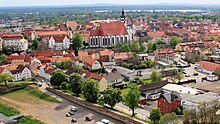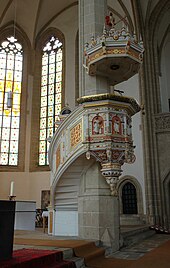Marienkirche (Torgau)
The Marienkirche in Torgau in Saxony is a late Gothic hall church with older parts. It belongs to the evangelical parish of Torgau in the parish of Torgau-Delitzsch of the Evangelical Church in Central Germany and contains a wealth of furnishings, some of which are artistically valuable.
Building history
The construction of the church goes back to Romanesque origins, which have been preserved in the west of the church. They come from a Romanesque basilica that was built between 1200 and 1220. Today's hall church was probably built after 1380 starting with the choir. The three naves are polygonal in the east. The central nave is extended by a choir. The roof structure of the hall church was dendrochronologically dated to 1463. After 1464 the vaults of the nave were built.
The church has a double tower over the Romanesque west building. The late Gothic west portal dates from around 1516. The choir vaults from 1480/90 and the late Gothic sacristy are based on a design by Hans von Torgau . A total renovation of the nave was carried out in the years 1692–98, with the altarpiece and the grave of the Duchess of Saxony being moved to the southern side choir. The south tower was raised during a renovation after a fire between 1748 and 1751 and completed with a hood and lantern .
Restorations were made in 1885, 1927 and since 1967. During the last-mentioned restoration, the color of the interior from 1492 was restored.
architecture
The church in its current form is a late Gothic hall church with five almost square bays. The side aisles in the east are provided with a five- eighth end, the central nave merges into a single-nave, three-bay, slightly irregular choir, which is also provided with a five-eighth end. The structure was made of plastered porphyry rubble masonry with sandstone structures. The ogival, two- and three-lane windows are provided with varied tracery. A ten-part rose window from the end of the 14th century is arranged above the keel-arched central nave portal with framework . The structure is provided with gabled buttresses on the nave and choir.
The nave is covered with a gable roof that is hipped towards the east, the choir with a lower gable roof. Simple octagonal pillars, which merge into the dividing arches without a fight , divide the space into three naves. The fourth yoke of the light and wide, well-proportioned hall church is closed in the central nave by a star vault, the other yokes by ribbed vaults. The choir is closed with a combined cell network vault. The keystones of this vault are richly decorated with colored half-figures, including a wild man and a wild woman with coats of arms, an angel and to the east of it Mary with Child and Man of Sorrows based on Schongauer engravings. In the west of the nave there is a narrow stone gallery with octagonal pillars and paneled parapet from around 1520.
The fourth yoke is highlighted by a polygonal cultivation in nave height on the south side, the south with a small rib-vaulted vestibule with a steep, crabs - and fialengeschmücktem is provided gable. A small stair tower from 1614/15 and a crypt from 1725 adjoin the west side of the polygon. In the angle between the south polygon and the south side choir, the asymmetrical, two-storey sacristy with irregular net vaults on the ground floor and cell vaults on the upper floor is added.
Furnishing
Altars and liturgical furnishings

The marble altarpiece is a work based on a design by the master builder and plasterer Giovanni Simonetti . The sculptural work was mainly carried out by Santino Caprani in the years 1694–97, decorated with paintings by Johann Heinrich Sperling and colored and gilded by Nikolaus Prescher. A restoration was carried out in 1971-74. The altarpiece consists of a high column structure made of wood and stucco and is finished with a segmented arch gable and an attachment. Passages are arranged on the side. The paintings show a representation of the Last Supper in the predella , in the main picture a representation of the crucifixion of Christ, flanked by two Corinthian columns and the evangelists Matthew and Mark. On the gable the evangelists Lukas and Johannes are depicted with the Salvator mundi and two grave guards as crowning.
The richly carved pulpit with evangelists dates back to 1582 by Georg Wittenberger, was redesigned in 1692/93 and provided with further figural decorations by Gottfried Fischer and Nikolaus Beseler. A pulpit clock is attached to the parapet of the pulpit . The marble baptismal font from 1693 was made by Hans Nicolaus Meyer and is richly decorated with putti bearing fruit and coats of arms , acanthus , vine and oak leaves.
An altar panel depicting the Fourteen Holy Helpers is an important early work by Lucas Cranach the Elder , which was created around 1505/06 after his stay in Vienna in connection with his settlement as court painter in Wittenberg . The board shows half-figure representations with differentiated and expressive physiognomy. On the back the Man of Sorrows is shown , accompanied by two grieving angels.
A late Gothic passion altar from 1509, probably of Central German origin, was probably created for the Holy Cross Chapel, which was demolished in 1533. In 1945 the right half of the central panel was destroyed and neutralized during a restoration in 1970/71. The painted winged altar shows a crucifixion rich in figures on the central panel; on the back the handkerchief of St. Veronica was depicted with the donor's coat of arms and the date. On the inside of the wings the bearing of the cross, the attachment of the cross, the erection and the descent from the cross are depicted, on the outside the mockery, the crowning of thorns, the ecce homo depiction and the flagellation of Christ.
From an altar from the end of the 15th century comes a left wing with the image of John the Evangelist on the front and a holy bishop on the back. A painting of the Transfiguration of Christ was made in the second half of the 17th century. The memorial picture for Christian Ganzland († 1710) shows the deceased as an oval knee in an ornate frame.
A late Gothic carved altar from around 1520 from Pausnitz is kept in the sacristy . The shrine depicts the third of Anna herself and Saints Catherine and Nicholas , and the apostles in the wings. The painting on the outside is no longer recognizable. A painting of Christ carrying the grave was made by Michael Eckart in 1608.
Gravestones, epitaphs and other sculptures
The Marienkirche in Torgau is famous for its epitaphs and tombs. Particularly noteworthy is the finely engraved brass grave plate with an elaborately chased frame for Sophie von Mecklenburg , who died in Torgau in 1503 , the first wife of the later Elector Johann the Constant , from the workshop of Peter Vischer the Elder in Nuremberg, which is dated to 1504. It is located in the southern side choir and is surrounded by a baroque grille with the coat of arms of the deceased. More famous, however, is the figural tombstone of Katharina von Bora , who died in Torgau in 1552 , the widow of Martin Luther , who had an accident in a carriage while fleeing the plague and succumbed to her injuries. The tombstone was restored by Wolf Mönch in 1617 and provided with inscriptions and a coat of arms.
Figurative tombstones of Magdalena Drandorf († 1574), Anna Stamer († 1577) and an unknown woman († 1628) also deserve mention. A damaged marble epitaph from around 1570/80 with a very fine relief depicts the entombment of Christ and smaller scenes from the Old Testament and is stylistically close to Georg Schröter. Among the numerous other grave monuments on the outer wall, mostly from the 17th and 18th centuries. Century, there is also the figural tombstone of the builder of the Hartenfels Castle, Konrad Krebs, who died in 1540, with a compass, scale and coat of arms. Further grave monuments are placed in the southern entrance hall, of which the epitaph of Hans Wurm von Thomsbrück († 1570) by Georg Schröter should be mentioned.
Three pastor portraits from the 18th century are also among the church's numerous sculptures. In the western vestibule there is a stone tablet with the relief of the mercy seat from Hartenfels Castle after an engraving by Albrecht Dürer , which is attributed to Stephan Hermsdorf. In the southern side choir there is a well-designed figure of the Virgin Mary made of oak from House Fleischmarkt 5, which may have come from an Annunciation group from the end of the 15th century.
organ
The organ of the Marienkirche was built in 1984 by the organ builder Siegfried Schuster (Zittau). The instrument has 41 registers (slider drawers) on 3 manuals and a pedal . The playing and stop actions are mechanical.
|
|
|
|
|||||||||||||||||||||||||||||||||||||||||||||||||||||||||||||||||||||||||||||||||||||||||||||||||||||||||||||||||||||||||||||||||||||||||||||||
- Coupling: II / I, III / I, I / P, II / P
literature
- Georg Dehio (greeting), Barbara Bechter (editing): Saxony, Vol. 2 ( Dehio manual ). Deutscher Kunstverlag, Munich 1998, ISBN 3-422-03048-4 .
- Heinrich Magirius : The Marienkirche . In: Peter Findeisen, Heinrich Magirius (edit.): The monuments of the city of Torgau . Seemann, Leipzig 1976
- Heinrich Magirius: Marienkirche Torgau . (= Small Art Guide; 1995). 3. Edition. Schnell & Steiner, Regensburg 2007, ISBN 978-3-7954-5722-8 (36 pages)
Individual evidence
- ^ Dorothee Reimann: The hourglass in St. Marien zu Torgau . In: Monumente , vol. 2005, issue 11/12, pp. 22–23.
- ↑ Information on the organ of the Marienkirche
Web links
Coordinates: 51 ° 33 '36.4 " N , 13 ° 0' 22.8" E







